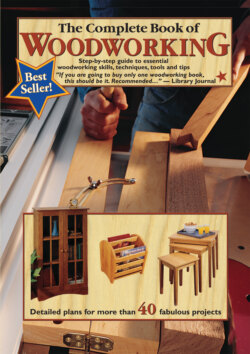Читать книгу Draw Manga - Tom Carpenter - Страница 18
На сайте Литреса книга снята с продажи.
Introduction to Wood
ОглавлениеChoosing lumber for your project is as much a part of woodworking as any other step in the process. Lumber is expensive, so it pays to know what your options are before you head to the lumberyard—sometimes an economical species will serve the same function as a more costly alternative.
In addition, each wood type has natural characteristics that influence workability, appearance and durability. It’s important to be aware of these factors before you build. Hardwood and softwood lumber is sold in various industry grades based on the percentage of clear (knot-free) lumber the board must have, as well as whether or not the boards are planed at the mill or left roughsawn. You’ll need to pick a lumber grade that is suitable for your project needs, tools available to you and your project budget, then sift through stacks of boards carefully—lumber within the same grade can vary widely in terms of color, figure and defects.
WOODWORKING WORKS
One of the distinctive features of this tool chest is how the design integrates contrasting wood types. While the majority of the project is made of white oak, the drawer pulls and lid edge are walnut. Generally, the most attractive approach is to pair light and dark woods and limit the contrast to two wood types.
So how do you choose which species to use and which boards to buy? Making good lumber choices to some extent comes only by experience. You’ll need to build with different species and grades of wood to know what truly works best for projects intended for different purposes. But familiarizing yourself with the various topics covered in this chapter is a good first step to buying smart.
In the pages that follow you’ll become familiar with distinctions between hardwoods, softwoods and sheet goods and examine some of their different uses. Learn about figure and defects in lumber, see how mills cut logs into boards, and discover how wood reacts to changes in moisture. We’ll cover how lumber is sized and sold, as well as overview the standardized lumber grading systems. Finally, the end of the chapter reveals some time-tested guidelines about where and how to shop for lumber like a pro.
Once you’ve read this chapter and calculated the quantity and quality of boards your project requires, you can venture more confidently off to the lumberyard to pilfer through stacks of boards. You may even save a bit of money in the process.
Woodworking Wisdom
A woodworker in Wyoming once sent me some photographs of a cigar humidor he had built from a plan of mine. It was a Honduras mahogany box with brass inlay, a gift for his father-in-law who enjoyed an occasional stogie. The accompanying cover letter said that he was especially proud of the beautiful cedar lining that he had custom-fitted to the interior. But when I got to that photo, my heart sank. This well-intentioned fellow had unfortunately lined the humidor with aromatic instead of Spanish cedar. If the humidor had been used, his father-in-law’s cigar collection would have been ruined by the strong cedar smell. Instances like this illustrate an important lesson when selecting wood for a project: Be sure to consider the characteristics of the wood species you choose before you build. It can make or break a project.
~John English
